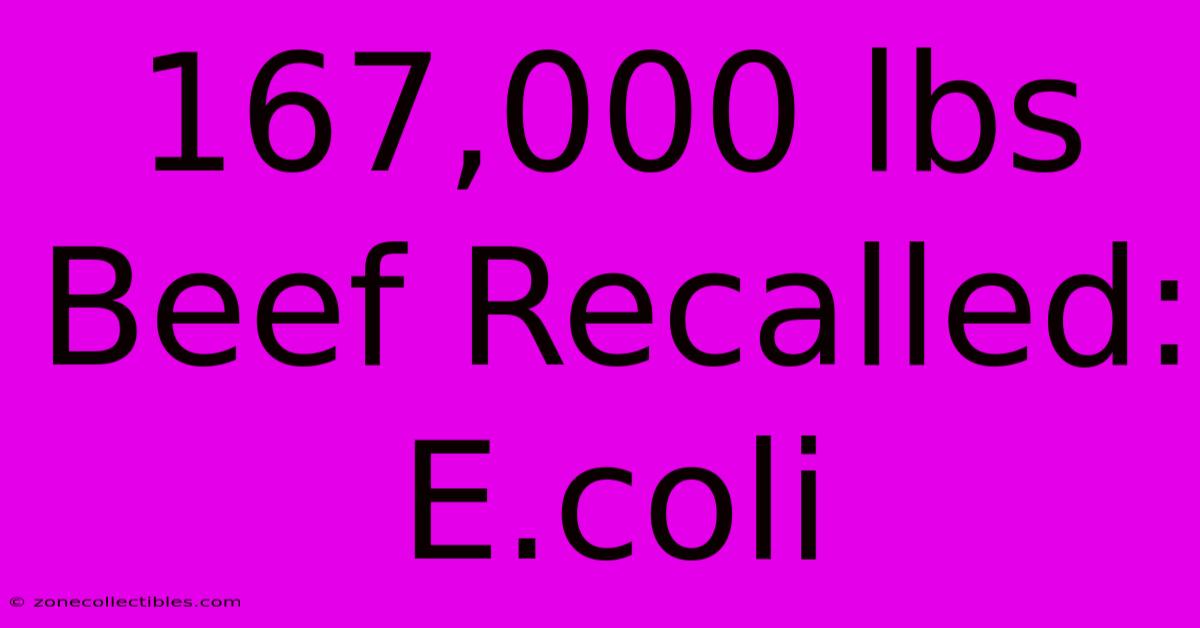167,000 Lbs Beef Recalled: E.coli

Discover more detailed and exciting information on our website. Click the link below to start your adventure: Visit Best Website. Don't miss out!
Table of Contents
167,000 lbs Beef Recalled: E.coli Outbreak Investigation
Is a massive beef recall due to E.coli contamination a serious public health threat? Absolutely. This recall underscores the critical importance of food safety. Editor's Note: This article provides comprehensive details regarding the 167,000 lbs beef recall due to E.coli contamination. Understanding the scale and implications of this recall is crucial for consumer safety and preventative measures.
Why This Matters: This recall highlights the ever-present risk of foodborne illnesses and the importance of stringent food safety protocols throughout the beef production and distribution chain. The potential for widespread health consequences necessitates a thorough understanding of the recall's details, including affected products and preventative actions. This article summarizes the recall, analyzing its impact and offering guidance for consumers.
Analysis: This analysis draws upon official recall notices from the USDA's Food Safety and Inspection Service (FSIS), news reports, and public health advisories to deliver a comprehensive overview. The aim is to provide clear, factual information to help readers understand the risks and take appropriate precautions.
| Key Recall Information | Details |
|---|---|
| Amount Recalled | 167,000 pounds of beef products |
| Contaminant | Escherichia coli (E. coli) O157:H7 |
| Source | [Insert Source of Beef - e.g., specific processing plant, company name] |
| Date of Recall | [Insert Date of Recall] |
| Action Required | Consumers urged not to consume the recalled products; return to place of purchase. |
Beef Recall: Understanding the E.coli Contamination
Introduction: This section outlines the critical aspects of the beef recall, focusing on the nature of the contamination, the scale of the recall, and the potential health consequences.
Key Aspects:
- E.coli O157:H7 Contamination: A serious foodborne pathogen causing severe illness.
- Recall Scale: The magnitude of 167,000 lbs signifies a significant potential for widespread impact.
- Public Health Risk: The severity of E. coli infection warrants immediate action.
- Product Identification: Accurate identification of recalled products is crucial for consumer safety.
- Distribution Channels: Understanding where the contaminated beef was distributed is essential for containment.
E.coli O157:H7: Symptoms and Risks
Introduction: This section delves into the specific characteristics of E. coli O157:H7, emphasizing its health implications and the necessity for prompt action upon consumption of contaminated beef.
Facets:
- Symptoms: Diarrhea (often bloody), vomiting, abdominal cramps, and fever.
- Severity: Can range from mild to life-threatening complications, particularly in vulnerable populations.
- Transmission: Primarily through consumption of contaminated food, particularly undercooked beef.
- Treatment: Supportive care; severe cases may require hospitalization.
- Prevention: Thorough cooking of beef to an internal temperature of 160°F (71°C).
- Risk Mitigation: Proper handwashing and safe food handling practices.
Recall Impact and Response
Introduction: This section examines the consequences of the recall, focusing on its implications for consumers, the beef industry, and public health agencies.
Further Analysis:
The recall forces consumers to exercise caution, potentially altering purchasing habits and increasing awareness of food safety. The economic impact on the involved company and the wider beef industry should also be considered. The recall underscores the need for improved food safety regulations and enforcement.
Frequently Asked Questions (FAQ)
Introduction: This section addresses common questions and concerns regarding the E.coli-contaminated beef recall.
Questions:
- Q: What are the symptoms of E. coli O157:H7 infection?
- A: See the previous section on Symptoms and Risks.
- Q: How can I identify recalled products?
- A: Check the USDA's FSIS website for detailed product information and lot numbers.
- Q: What should I do if I have consumed the recalled beef?
- A: Monitor for symptoms. If symptoms develop, seek medical attention.
- Q: How long does it take for E.coli symptoms to appear?
- A: Symptoms can appear within 2-10 days after consumption.
- Q: What measures are being taken to prevent future occurrences?
- A: Further investigation will determine the source and implement improvements to prevent recurrence.
- Q: Where can I find more information about the recall?
- A: Check the official USDA's FSIS website and related news sources.
Tips for Safe Beef Handling
Introduction: This section provides practical tips to minimize the risk of foodborne illnesses associated with beef consumption.
Tips:
- Always cook beef thoroughly to an internal temperature of 160°F (71°C).
- Wash hands thoroughly before and after handling raw beef.
- Keep raw beef separate from other foods to prevent cross-contamination.
- Clean and sanitize all surfaces that come into contact with raw beef.
- Refrigerate cooked and raw beef promptly.
Recall Conclusion and Future Outlook
Recall Summary: The 167,000-pound beef recall due to E. coli O157:H7 contamination highlights the significant risks associated with foodborne illnesses and the crucial role of food safety measures in protecting public health. The recall's impact extends beyond immediate consumer safety concerns to underscore the necessity for robust regulatory oversight and stringent industry practices.
Closing Message: This incident serves as a stark reminder of the potential consequences of inadequate food safety protocols. Continued vigilance, thorough investigation, and improved industry standards are vital to prevent future outbreaks and safeguard public health.

Thank you for visiting our website wich cover about 167,000 Lbs Beef Recalled: E.coli. We hope the information provided has been useful to you. Feel free to contact us if you have any questions or need further assistance. See you next time and dont miss to bookmark.
Featured Posts
-
Tabla Liga Profesional Velez Igualo
Nov 22, 2024
-
Pi S Z Kim Do Wyborow
Nov 22, 2024
-
Kandydat Pi S Odpowiedz Ko
Nov 22, 2024
-
Deutsche Kennen Polen Wenig Umfrage
Nov 22, 2024
-
Draft Kings Fan Duel Tnf Fantasy Picks
Nov 22, 2024
